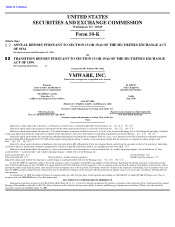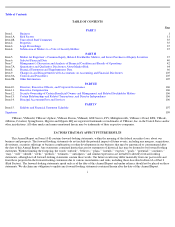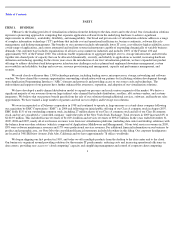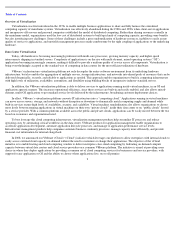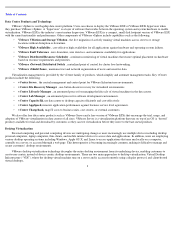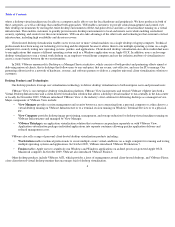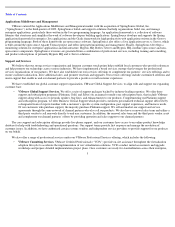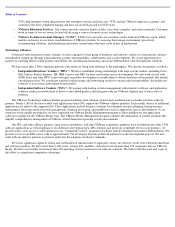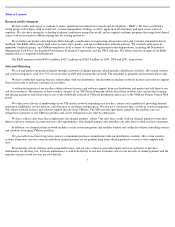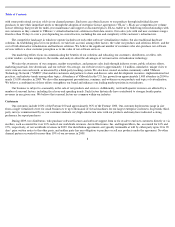VMware 2009 Annual Report Download - page 12
Download and view the complete annual report
Please find page 12 of the 2009 VMware annual report below. You can navigate through the pages in the report by either clicking on the pages listed below, or by using the keyword search tool below to find specific information within the annual report.
Table of Contents
Competition
The virtualization market is rapidly evolving, and as such, we experienced increased competition during 2009, and we expect competition
to significantly intensify in the future. We compete with both large and small vendors in different segments of the virtualization market, and we
expect that new entrants will continue to enter the market and develop technologies that, if commercialized, may compete with our products.
We believe that the key competitive factors in the virtualization market include:
Microsoft is the primary competitor for our data center virtualization solutions. In 2009, Microsoft released the second generation of its
Hyper-V virtualization offering and continues to develop virtual management products. Microsoft also continues to articulate a cloud-based
computing initiative. Microsoft’s offerings are positioned to compete with our virtual infrastructure, virtualization management, and some of our
free data center product offerings. Microsoft’
s cloud initiative may eventually compete with our cloud offerings and with cloud service providers
who standardize on our solutions. We believe our approach to both server virtualization and cloud computing is differentiated from Microsoft’s
and our solutions deliver significant flexibility, functionality, reliability, and superior economic value to customers.
We also compete with Citrix for desktop virtualization solutions and with companies whose virtualization products are based on emerging
open-source technologies. In addition, we compete with companies that take different approaches to virtualization. Furthermore, our VMware
vSphere suite competes with products that provide high availability clustering, workload management, and resource management.
We also expect to compete with new entrants to the virtualization market, which may include parties currently selling our products and/or
our current technology partners. Existing and future competitors may introduce products in the same markets we serve or intend to serve, and
competing products may have better performance, lower prices, better functionality, and broader acceptance than our products. Our competitors
may also add features to their virtualization products that are similar to features that presently differentiate our product offerings from theirs.
Additionally, some of our competitors may make acquisitions or enter into partnerships or other strategic relationships with one another to offer
a more comprehensive virtualization solution than they individually had offered. Some competitors have in the past, and may in the future, take
advantage of their existing relationships with our business partners to engage in business practices such as distribution and license restrictions
that make our products less attractive to our channel partners and end users. A number of companies have recently announced initiatives in these
areas.
Information technology companies are also increasingly seeking to deliver top-to-bottom IT solutions to end users that combine enterprise-
level hardware and software solutions that can offer alternatives to our virtualization platform. In addition, competitors who have existing
relationships with our current or prospective end users could integrate competitive capabilities into their existing products and make them
available without
9
•
the level of reliability and new functionality of product offerings;
•
the ability to provide full virtual infrastructure solutions;
•
the ability to offer products that support multiple hardware platforms and operating systems;
•
the proven track record of formulating and delivering a roadmap of virtualization capabilities;
•
pricing of products, individually and in bundles;
•
the ability to attract and preserve a large installed base of customers;
•
the ability to create and maintain partnering opportunities with hardware and infrastructure software vendors and development of
robust indirect sales channels; and
•
the ability to attract and retain virtualization and systems experts as key employees.


